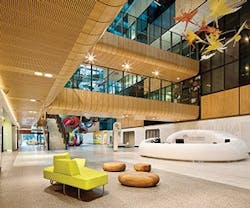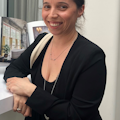It takes a village.
That’s the mantra international architecture and design firm HKS lives by when approaching any children’s hospital project. It’s also what they taught Australian firms Billard Leece Partnership (BLP) and Bates Smart Architects as they worked as international advisors on the Royal Children’s Hospital, located in Melbourne, Australia and completed in November of 2011.
“We served as guides, if you will,” says Ron Dennis, principal and senior vice president, as well as director of children’s health facilities design with HKS. Neither BLP nor Bates Smart had much experience designing children’s hospitals, so Dennis spent a significant amount of time working with the firms, reviewing possible design strategies.
“I talked to them about how you engage the community—can you get the zoo involved, can you get the women’s clubs, the auxiliaries,” Dennis explains. They also discussed wayfinding options, the use of gardens and other space utilization techniques. Then BLP and Bates Smart took those ideas and ran with them.
“The actual implementation of the interiors was developed out of the local architects, so what they’ve done in the inside of the facility and on the outside of the facility is an Australian response to what a children’s hospital needs to be,” Dennis says.
Thanks to both the Melbourne Zoo and the Melbourne Aquarium, nature’s influence played a major part in the hospital’s design. An impactful, mesmerizing two-story aquarium—notable for its sheer size and the rich color it brings to the project—extends from ground level opposite the main entry into the two emergency waiting areas. Staff from the aquarium assisted in the construction of the tank and have committed to its maintenance. A meerkat enclosure, similarly managed by the Melbourne Zoo, is situated in the busy outpatients’ waiting space on the ground floor and provides even more visual excitement for the patients.
“There were a number of groups that were able to be engaged,” Dennis says. “That brought a dimension that goes beyond a traditional hospital, and beyond a traditional children’s hospital. While we’ve done these kinds of things here, we’ve never had an opportunity to actually build a hospital in a park setting like that. And we’ve never had one that’s had such a direct relationship with the zoo.”
Located in Royal Park, adjacent to the site of Melbourne’s original children’s hospital, Royal Children’s was “independently assessed” to achieve a 5-star rating, based on the Green Building Council of Australia’s Green Star Healthcare pilot assessment tool, according to Mark Healey, associate director at Bates Smart.
“Royal Children’s employed a sophisticated, pioneering approach to establish an integrated blending of low- and high-tech appropriate technologies in response to the Victorian Government’s targets to reduce energy, carbon dioxide emissions and potable water use. The project brief set incredibly high sustainability criteria—levels never achieved by a healthcare project in Australia,” he says.
The design team delivered on a number of sustainable initiatives, including grouping clinical areas that operate 24 hours a day, seven days a week separately from those that only operate during core hours in order to reduce energy consumption. Thirty-four percent of the total floor area is within five meters of perimeter windows, optimizing natural daylight. And perhaps most importantly, 80 percent of bedrooms and all-day medical chairs overlook Royal Park. PageBreak
Another way nature’s influence makes its way indoors is via wayfinding. Melbourne illustrator Jane Reiseger was commissioned to produce eight illustrated Victorian environments (including Port Phillip Bay and Alpine Victoria) populated with animals that occupy each region. Components of these illustrations can be found throughout the hospital, and animals from each particular environment are also used to name wards (surgical care is provided in the platypus ward; cardiac patients stay in the koala ward).
"This strategy, developed by our wayfinding consultants, Büro North, resulted in a complex and rich child-friendly wayfinding strategy throughout the hospital, using the premise that young children navigate space through the recognition of a series of landmarks,” says Healey.
Natural light also assists in wayfinding. All elements of the hospital are linked together through a six-story, naturally lit public thoroughfare called Main Street, providing expansive views of the park. This tactic was based on an “assumption that our intuitive ability for wayfinding is enhanced if the natural environment is present,” Healey adds.
Contact Information
client
The Royal Children’s Hospital
50 Flemington Road
Parkville, Victoria 3052
Australia
+61 3 9345 5522
www.rch.org.au
project team
architecture + interiors
HKS Inc.
1919 McKinney Avenue
Dallas, TX 75201
(214) 969-5599
www.hksinc.com
Billard Leece Partnership
Level 7
180 Flinders Street
Melbourne, Victoria 3000
Australia
+61 3 9656 5000
www.blp.com.au
Bates Smart Architects
1 Nicholson Street
Melbourne, Victoria 3000
Australia
+61 3 8664 6200
www.batessmart.com.au
Large art objects help break down the scale of the building, keeping it accessible and friendly. “Creature,” an 8-ton, 14-meter high sculpture by Melbourne artist Alexander Knox, is one such example. It stands as the centerpiece of Main Street, acting as a landmark or meeting place. “I think it’s quite at home in the wonderful imaginations of a child,” says Healey.
The Royal Children’s Hospital is a space which ensures patients and their families that even though they may be sick, they don’t have to miss out on the wonder and magic of being a child. Another of the many community partnerships tapped for the project resulted in the hospital’s bean bag theatre, which shows current and often unreleased movies. Many times new releases are shown there first so patients don’t feel left out when a popular movie comes out in public theatres. Showtime begins with patients settling back into big, comfy and colorful bean bags scattered throughout the room.
Thanks to the local community embracing this project and adding their own special touches throughout, the Royal Children’s Hospital appeals to all ages—including parents and staff, who also spend a significant amount of time there. Perhaps Dennis says it best: “The hospital becomes more than just a place to go and be sick.”
About the Author
AnnMarie Martin
Editor-in-Chief
AnnMarie is the former Editor in Chief of i+s and has been covering the commercial design space. Her style and vision has helped the brand evolve into a thought leader in purpose-driven design and cultural movements shaping the way we live and work.

